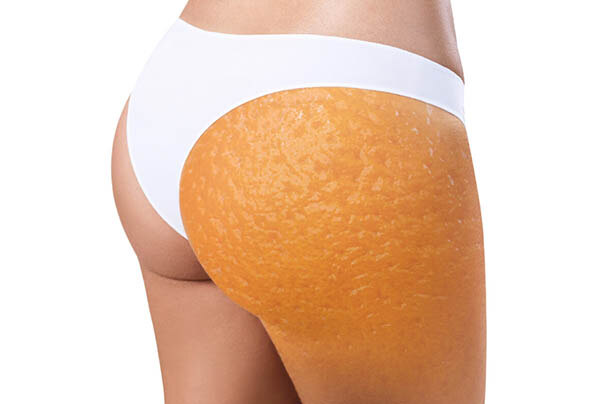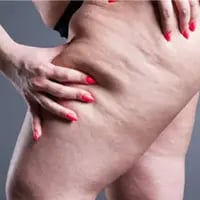What is Cellulite?
Unlocking the Secrets Behind Cellulite
Orange peel tissue is formed by the combination of fat cells accumulating and expanding under the skin and fibrous bands called septa extending perpendicular to the skin surface.
While the enlarged fat cells create small bulges, the tight septa shrink the adipose tissue and cause dimples.
Thus, a rough appearance emerges. It is referred to by different names in the medical literature, such as edematous fibrosclerotic radiculopathy, gynoid lipodystrophy, or adipose edema.

What Causes Cellulite?
Possible causes of cellulite include hormonal changes, genetic factors, weight gain or loss, unhealthy diet, sedentary lifestyle or smoking. There is also evidence that tight clothing and too much sitting can cause cellulite.
But many healthy women can develop cellulite despite a healthy diet and exercise program. The distribution of fat in the body can also predispose to cellulite.
Since many different factors can cause cellulite, almost all women may experience cellulite in any part of their body at some point.

Cellulite Treatment and Removal
There is no specific treatment option that is entirely effective for cellulite. The following treatments may improve the appearance of cellulite, at least temporarily:
Weight Lose for Overweight People
Slow and controlled weight loss of overweight individuals with a healthy diet and regular exercise can slightly improve the skin's unpleasant appearance.
However, sudden and rapid weight loss causes skin sagging and worsens cellulite's appearance.
Laser and Radiofrequency Systems
The most promising treatment option is the use of laser and radiofrequency systems. There are three different systems used in cellulite treatment.
All three systems provide improvement in the skin after a series of treatments. The results obtained can be permanent for up to six months. These systems may include:
The first uses a combination of tissue massage, radiofrequency technology, and infrared light to treat cellulite.
A combination of diode laser energy and tissue massage is preferred in another system.
The third system simultaneously uses deep and superficial radiofrequency levels to treat cellulite.
Laser Assisted Liposuction
Some people choose to have liposuction for cellulite treatment. During liposuction, fat cells are sucked with the help of a thin tube placed under the skin through a small incision on the skin.
Although liposuction alone shapes the body, it does not remove cellulite and may worsen the orange peel appearance.
Laser-assisted liposuction gives more effective results in cellulite treatment. This treatment is a different method of liposuction that destroys fat cells while tightening the skin.
Cryolipolysis
Cryolipolysis freezes lipid molecules in regional fat cells in areas of the body such as the hips and abdomen. This FDA-approved method is promising in improving the appearance of cellulite.
Ultrasound Treatment
This non-surgical method uses sound waves to reduce targeted fat cells in the abdomen and thighs. The results obtained are effective for 2 to 3 months.
Retinol Cream
Retinol is a vitamin A derivative that inhibits collagen formation and reduces free radicals. Twice daily application of 0.3% retinol cream has been shown to reduce the appearance of cellulite by smoothing the skin after six months.
Carboxytherapy
This treatment method is applied as carbon dioxide gas injection under the skin. Some cellulite can be treated with this method. It may cause side effects such as bruising and discomfort after the procedure.
Preparing for Your Appointment
Before starting cellulite treatment, it will be beneficial to lose some weight. Before coming to your appointment, you should get information from your doctor about this issue.
Also, remember preventing 100% cellulite formation is impossible. But this is because taking some precautions can reduce the formation of cellulite. An active lifestyle and a healthy diet can help minimize the appearance of cellulite.
In addition, maintaining a healthy body weight effectively reduces the degree of dimples on the thighs or abdomen. Muscle-strengthening exercises for the thighs and core can also help shape and lessen the areas where cellulite appears.
For those who are overweight, losing weight can help reduce the appearance of cellulite. But weight loss can also cause the condition to become more pronounced in some people.
Loose skin, which usually occurs after rapid and significant weight loss, can result in the appearance of cellulite becoming more noticeable.
For this reason, a weight loss program is recommended to allow the skin to stretch gradually and according to weight loss.
Taking good care of your skin helps reduce the appearance of cellulite. It can be effective to quit smoking and use sunscreen to help the skin stay softer, firmer, and more elastic.
Because tight skin can help reduce the appearance of cellulite.
Our mission is to create a world where every investment in modern beauty is Worth It.
Let's keep in touch
Get updates of the treatments you are interested
Living With Cellulite?
Aim of smile design is to create a smile that is aesthetically pleasing, natural-looking, and in harmony with the individual's facial features. The procedure is customized to meet the specific needs and desires of each individual patient.
To determine the best treatment plan the cosmetic dentist will evaluate the individuals facial features, including the shape of the lips, the size and position of the teeth, and the overall symmetry of the face.
Smile design can help to improve self-confidence and self-esteem, and may also have functional benefits such as improving the alignment of teeth or correcting bite issues.

Unlocking the Secrets Behind Cellulite
Orange peel tissue is formed by the combination of fat cells accumulating and expanding under the skin and fibrous bands called septa extending perpendicular to the skin surface.
While the enlarged fat cells create small bulges, the tight septa shrink the adipose tissue and cause dimples.
Thus, a rough appearance emerges. It is referred to by different names in the medical literature, such as edematous fibrosclerotic radiculopathy, gynoid lipodystrophy, or adipose edema.

Grades of Cellulite
What Causes Cellulite?
Possible causes of cellulite include hormonal changes, genetic factors, weight gain or loss, unhealthy diet, sedentary lifestyle or smoking. There is also evidence that tight clothing and too much sitting can cause cellulite.
But many healthy women can develop cellulite despite a healthy diet and exercise program. The distribution of fat in the body can also predispose to cellulite.
Since many different factors can cause cellulite, almost all women may experience cellulite in any part of their body at some point.

Cellulite Treatment and Removal
There is no specific treatment option that is entirely effective for cellulite. The following treatments may improve the appearance of cellulite, at least temporarily:
Weight Lose for Overweight People
Slow and controlled weight loss of overweight individuals with a healthy diet and regular exercise can slightly improve the skin's unpleasant appearance.
However, sudden and rapid weight loss causes skin sagging and worsens cellulite's appearance.
Laser and Radiofrequency Systems
The most promising treatment option is the use of laser and radiofrequency systems. There are three different systems used in cellulite treatment.
All three systems provide improvement in the skin after a series of treatments. The results obtained can be permanent for up to six months. These systems may include:
The first uses a combination of tissue massage, radiofrequency technology, and infrared light to treat cellulite.
A combination of diode laser energy and tissue massage is preferred in another system.
The third system simultaneously uses deep and superficial radiofrequency levels to treat cellulite.
Laser Assisted Liposuction
Some people choose to have liposuction for cellulite treatment. During liposuction, fat cells are sucked with the help of a thin tube placed under the skin through a small incision on the skin.
Although liposuction alone shapes the body, it does not remove cellulite and may worsen the orange peel appearance.
Laser-assisted liposuction gives more effective results in cellulite treatment. This treatment is a different method of liposuction that destroys fat cells while tightening the skin.
Cryolipolysis
Cryolipolysis freezes lipid molecules in regional fat cells in areas of the body such as the hips and abdomen. This FDA-approved method is promising in improving the appearance of cellulite.
Ultrasound Treatment
This non-surgical method uses sound waves to reduce targeted fat cells in the abdomen and thighs. The results obtained are effective for 2 to 3 months.
Retinol Cream
Retinol is a vitamin A derivative that inhibits collagen formation and reduces free radicals. Twice daily application of 0.3% retinol cream has been shown to reduce the appearance of cellulite by smoothing the skin after six months.
Carboxytherapy
This treatment method is applied as carbon dioxide gas injection under the skin. Some cellulite can be treated with this method. It may cause side effects such as bruising and discomfort after the procedure.
Preparing for Your Appointment
Before starting cellulite treatment, it will be beneficial to lose some weight. Before coming to your appointment, you should get information from your doctor about this issue.
Also, remember preventing 100% cellulite formation is impossible. But this is because taking some precautions can reduce the formation of cellulite. An active lifestyle and a healthy diet can help minimize the appearance of cellulite.
In addition, maintaining a healthy body weight effectively reduces the degree of dimples on the thighs or abdomen. Muscle-strengthening exercises for the thighs and core can also help shape and lessen the areas where cellulite appears.
For those who are overweight, losing weight can help reduce the appearance of cellulite. But weight loss can also cause the condition to become more pronounced in some people.
Loose skin, which usually occurs after rapid and significant weight loss, can result in the appearance of cellulite becoming more noticeable.
For this reason, a weight loss program is recommended to allow the skin to stretch gradually and according to weight loss.
Taking good care of your skin helps reduce the appearance of cellulite. It can be effective to quit smoking and use sunscreen to help the skin stay softer, firmer, and more elastic.
Because tight skin can help reduce the appearance of cellulite.
Our mission is to create a world where every investment in modern beauty is Worth It.
Let's keep in touch
Get updates of the treatments you are interested
Living With Cellulite?
Aim of smile design is to create a smile that is aesthetically pleasing, natural-looking, and in harmony with the individual's facial features. The procedure is customized to meet the specific needs and desires of each individual patient.
To determine the best treatment plan the cosmetic dentist will evaluate the individuals facial features, including the shape of the lips, the size and position of the teeth, and the overall symmetry of the face.
Smile design can help to improve self-confidence and self-esteem, and may also have functional benefits such as improving the alignment of teeth or correcting bite issues.







